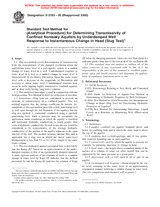Potrebujeme váš súhlas na využitie jednotlivých dát, aby sa vám okrem iného mohli ukazovať informácie týkajúce sa vašich záujmov. Súhlas udelíte kliknutím na tlačidlo „OK“.
ASTM D5785-95(2000)
Standard Test Method for (Analytical Procedure) for Determining Transmissivity of Confined Nonleaky Aquifers by Underdamped Well Response to Instantaneous Change in Head (Slug Test)
Automaticky preložený názov:
Štandardná skúšobná metóda pre ( analytický postup ) na stanovenie priepustnosti obmedzená Nonleaky aquifers od Underdamped Well reakciu na okamžité zmeny vo Head ( Slug Test )
NORMA vydaná dňa 1.1.2000
Informácie o norme:
Označenie normy: ASTM D5785-95(2000)
Poznámka: NEPLATNÁ
Dátum vydania normy: 1.1.2000
Kód tovaru: NS-32535
Počet strán: 5
Približná hmotnosť: 15 g (0.03 libier)
Krajina: Americká technická norma
Kategória: Technické normy ASTM
Anotácia textu normy ASTM D5785-95(2000) :
Keywords:
aquifers, aquifer tests, control wells, ground water, hydraulic conductivity, slug test, storage coefficient, transmissivity, ICS Number Code 93.160 (Hydraulic construction)
Doplňujúce informácie
| 1. Scope | ||||||||
|
1.1 This test method covers determination of transmissivity from the measurement of the damped oscillation about the equilibrium water level of a well-aquifer system to a sudden change of water level in a well. Underdamped response of water level in a well to a sudden change in water level is characterized by oscillatory fluctuation about the static water level with a decrease in the magnitude of fluctuation and recovery to initial water level. Underdamped response may occur in wells tapping highly transmissive confined aquifers and in deep wells having long water columns. 1.2 This analytical procedure is used in conjunction with the field procedure Test Method D4044 for collection of test data. 1.3 Limitations -Slug tests are considered to provide an estimate of transmissivity of a confined aquifer. This test method requires that the storage coefficient be known. Assumptions of this test method prescribe a fully penetrating well (a well open through the full thickness of the aquifer), but the slug test method is commonly conducted using a partially penetrating well. Such a practice may be acceptable for application under conditions in which the aquifer is stratified and horizontal hydraulic conductivity is much greater than vertical hydraulic conductivity. In such a case the test would be considered to be representative of the average hydraulic conductivity of the portion of the aquifer adjacent to the open interval of the well. The method assumes laminar flow and is applicable for a slug test in which the initial water-level displacement is less than 0.1 or 0.2 of the length of the static water column. 1.4 This test method of analysis presented here is derived by van der Kamp (1) based on an approximation of the underdamped response to that of an exponentially damped sinusoid. A more rigorous analysis of the response of wells to a sudden change in water level by Kipp (2) indicates that the method presented by van der Kamp (1) matches the solution of Kipp (2) when the damping parameter values are less than about 0.2 and time greater than that of the first peak of the oscillation (2). 1.5 This standard does not purport to address all of the safety concerns, if any, associated with its use. It is the responsibility of the user of this standard to establish appropriate safety and health practices and determine the applicability of regulatory limitations prior to use. |
||||||||
| 2. Referenced Documents | ||||||||
|




 Cookies
Cookies
